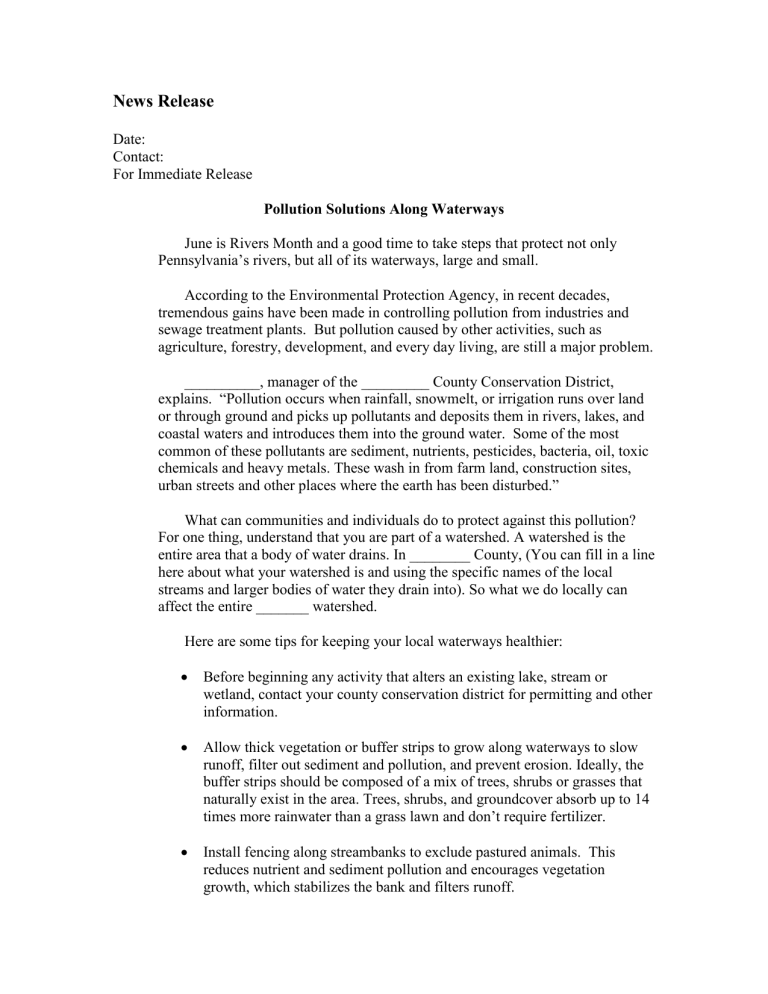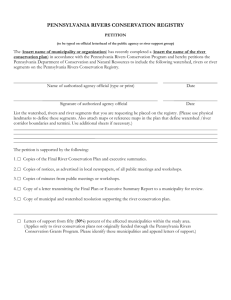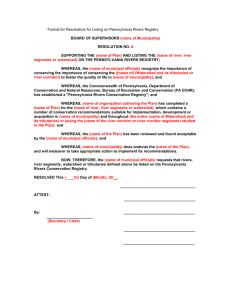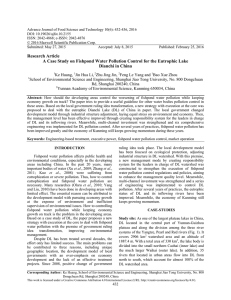News Release

News Release
Date:
Contact:
For Immediate Release
Pollution Solutions Along Waterways
June is Rivers Month and a good time to take steps that protect not only
Pennsylvania’s rivers, but all of its waterways, large and small.
According to the Environmental Protection Agency, in recent decades, tremendous gains have been made in controlling pollution from industries and sewage treatment plants. But pollution caused by other activities, such as agriculture, forestry, development, and every day living, are still a major problem.
__________, manager of the _________ County Conservation District, explains. “Pollution occurs when rainfall, snowmelt, or irrigation runs over land or through ground and picks up pollutants and deposits them in rivers, lakes, and coastal waters and introduces them into the ground water. Some of the most common of these pollutants are sediment, nutrients, pesticides, bacteria, oil, toxic chemicals and heavy metals. These wash in from farm land, construction sites, urban streets and other places where the earth has been disturbed.”
What can communities and individuals do to protect against this pollution?
For one thing, understand that you are part of a watershed. A watershed is the entire area that a body of water drains. In ________ County, (You can fill in a line here about what your watershed is and using the specific names of the local streams and larger bodies of water they drain into). So what we do locally can affect the entire _______ watershed.
Here are some tips for keeping your local waterways healthier:
Before beginning any activity that alters an existing lake, stream or wetland, contact your county conservation district for permitting and other information.
Allow thick vegetation or buffer strips to grow along waterways to slow runoff, filter out sediment and pollution, and prevent erosion. Ideally, the buffer strips should be composed of a mix of trees, shrubs or grasses that naturally exist in the area. Trees, shrubs, and groundcover absorb up to 14 times more rainwater than a grass lawn and don’t require fertilizer.
Install fencing along streambanks to exclude pastured animals. This reduces nutrient and sediment pollution and encourages vegetation growth, which stabilizes the bank and filters runoff.
Designate no-mow areas. Not mowing adjacent to streams promotes plant growth and water filtration. Plus, it creates excellent wildlife habitat.
Keep litter, pet wastes, leaves and debris out of street gutters and storm drains. These drain directly to lakes, streams, rivers, and wetlands.
Control soil erosion by planting groundcover and stabilizing erosion prone areas.
Encourage local government officials to develop construction erosion/sediment control ordinances in your community.
Support wetland preservation.
Support “best management practices” on agricultural land and construction sites.
Many resources are available for guidance on these activities. Start by contacting your county conservation district at _________ (give as much contact information as possible) or the Pennsylvania Association of Conservation
Districts, Inc. (PACD) at www.pacd.org
.
(Information for this article was provided by the Pennsylvania Association of Conservation
Districts, Inc., the U.S. Environmental Protection Agency, the Pennsylvania Department of
Environmental Protection, and Lancaster County Conservation District.)







